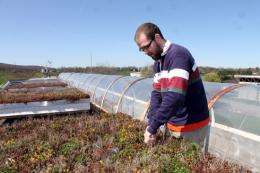Green roof design may help control urban runoff

(�鶹��Ժ) -- A research team in the College of Architecture and Urban Studies at Virginia Tech has released early results of an experimental study testing the effects of green roofs on controlling urban runoff.
Using 8-by-8-foot elevated platforms, the team found that green roofs reduced and slowed runoff during the first five months of the two-year project. The platforms for the experiment were installed at the university’s Research and Demonstration Facility by students and volunteers from Systems Construction LLC.
“We want to determine the effectiveness of various depths and types of green roofing systems,” said Elizabeth Grant, assistant professor of architecture and lead investigator for the project. “Our goal is to help architects more accurately predict the benefits of these systems and begin to support a healthy equilibrium between natural and manmade storm drainage systems.”
Green roofs have been shown to lessen the force of stormwater runoff and reduce combined sewer overflows because their vegetation and soil act a sponge, absorbing and filtering water that would normally plunge down gutters and wash through polluted urban streets, flood and erode rural areas, and threaten to pollute waterways. Green roofs also produce shade and help cool buildings, which is especially beneficial in urban areas where building materials retain heat.
Grant’s study compares roof runoff rates from the plywood platforms covered with white reflective thermoplastic roof membranes donated by GAF Materials Corporation and three different depths of modular green roof covering: 6 inches (referred to as Deep), 4.25 inches (Standard), and 2.5 inches (Lite). The study also includes a platform that contains a 4.25-inch depth of growing medium but no plants (Medium-only) as well as a control platform. The LiveRoof brand modules were donated by Riverbend Nursery in Riner, Va.
A weather station was installed to record air temperature, relative humidity, radiation, wind speed and direction, and rainfall. During the test period, 49 storms were recorded.
Results showed the Deep, Standard, Lite, and Medium-only platforms retained more rainfall than the control platform, and in general, the deeper systems exhibited more retention capacity than the shallower systems. The study also found that the total rainfall volume of the storm affected the retention properties of the test roofs, with more retention capacity as a percentage of rainfall exhibited in lighter storms than in heavier storms.
Other early findings concluded that depth and other properties of the growing medium may be as critical as the presence or absence of vegetation to reducing storm water runoff and that vegetated platforms and the Medium-only platform retained 90 percent or more of the rainfall for the light and medium storms.
“It was only in the heavy storms that the performance of the vegetated and medium-only platforms began to decline considerably,” Grant said.
In the coming months, Grant and her research team will continue collecting data on the effects of various types of green roof modules on reduction of runoff and will also examine more thoroughly how weather variables affect runoff delay.
“Green roofs continue to be a promising means to integrate natural and built environments,” Grant said. “But before designing these systems, architects need to be able to answer the question, ‘How well do they work?’”
Provided by Virginia Tech


















